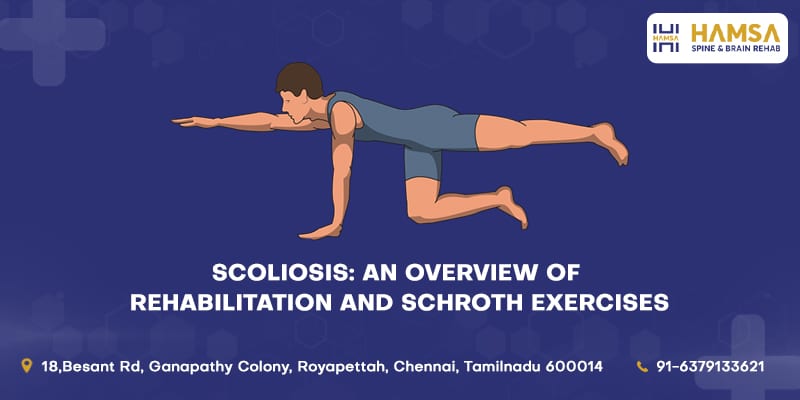

Scoliosis rehabilitation is imperative to maintain the overall health and to prevent the symptoms occurring in the long term. The focus of active recovery should be to prevent the progression of spine curvature while correcting the deformities, as well as to improve the quality of life. A proper diagnosis supported by X-rays is essential to evaluate the patients for suitable treatment. Recent studies have shown that Physiotherapeutic Scoliosis-specific exercises (PSSE) and bracing have an immensely positive impact in about 80% of symptomatic adult Scoliosis patients. You can get in touch with a professional rehabilitation centre in Chennai to gain insights and get treatments that include physical rehabilitation and Schroth exercises for Scoliosis patients.
Scoliosis The primary goals of physical and occupational therapy are to help patients who have undergone Posterior Spinal fusion (PSF), a safe recovery, and mobility. Patients with progressive deformity, who underwent surgery, hugely rely on this intensive rehabilitation program to have a safe home discharge. The rehabilitation requires a well-coordinated effort from medical, nursing and rehabilitation providers as well. The therapy goals include; assisting the patients in moving out of beds, ambulating on flat ground, navigating stairs, and performing day-to-day activities effectively. Survey of Shriners Hospital surgeons lays out sitting on day1, standing on day2, and walking on day three as the primary physical therapy goals.
Also Read: Treatment Of Scoliosis In Kids And Adults
How does HAMSA rehab help in Scoliosis rehabilitation? HAMSA rehab helps its patients who underwent PSF, to return home safely with an improved strength as well as confidence. The whole process occurs in parallel with the healing of the surgical site and arthrodesis (surgical immobilization of a joint by fusion of the bones) of the spines. Coordination, attaining equilibrium, auto-correction 3D, ergonomic corrections, muscular endurance, neuromotor control of the spine, increase of ROM, improving the respiratory capacity and side shift are the primary goals of their physical therapy.
Schroth methods of exercises are an efficient non-surgical option for Scoliosis treatment. The activities are customized for each patient that helps the curved spine return to the natural position. The exercises help to elongate, de-rotate, and stabilize the spine in a 3D plane. Professionals achieve all these while focusing on rehabilitating muscular symmetry and the alignment of posture, encouraging patients to breathe into the concave side of the body, and making them understand their correct posture.
Essential components of Schroth exercises
Muscular Symmetry The curvature of the spine in a Scoliosis patient can also affect the muscles in the back. In Scoliosis patients, it is observed that when muscles on one side of the back weaken and deteriorate, the other side will be overworked. Schroth exercises focus on eliminating these and achieving muscular symmetry.
Rotational angular breathing This is a crucial breathing technique of Schroth exercise. The breathing exercise helps to rotate the spine and also helps to reshape the ribcage as well as the surrounding soft tissues.
Teaching the patients their right posture Katharina Schroth relied on mirrors to focus on the correct positions. The exercise’s primary motive is to make the followers aware of their proper posture. It is essential to be mindful of the postures that can make your Scoliosis even worse.
Overall, Schroth exercise program is instrumental in improving postures & core stability, helps in more relaxed breathing, alleviates pain, improves overall movement, aligns pelvis perfectly and improves the awareness of spine health & management among the Scoliosis patients.
National Scoliosis awareness month campaign focuses on the importance of early screening and effectiveness of bracing in non-surgical procedures. The campaign also aims to increase awareness about Scoliosis through educational events and community events. Collaborating with physicians, patients, families and clinicians to educate patients is yet another objective of the campaign.